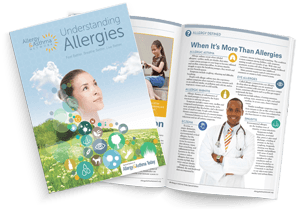How to Use Nasal Spray
- Home
- |
- A Complete Guide to Allergies
- |
- How are Allergies Treated?
- |
- How to Use Nasal Spray
Nasal sprays deposit allergy medication right where you need it – directly on the lining of nasal passages. This gives you maximum benefits of the medication – relieving and preventing nasal congestion, runny nose and sneezing – with minimal side effects because there’s no need to medicate your entire body just to clear up your nose.
Nasal sprays come in two basic types: traditional water-based solutions in a pump spray and waterless “dry” aerosols in canister sprays with dose counters.
Proper technique is critical to get results you need for relief from symptoms.

Nasal Spray Step-by-Step Instructions
Read the package insert instructions for patients before using the first time, as each medication is different. Look for information on how to prime and clean; how to hold and position the canister or pump; and whether to inhale or not.
- Prime the spray as directed before the first use or if you haven’t used it in a while.
- Blow your nose gently to clear out mucus before using the spray. This will allow the medicine to get up into the nasal passages. If you are severely congested, you may need a nasal wash or a decongestant for a few days to open up your nose before you spray.
- Gently insert the tip of the nasal spray ¼ to ½ inch into your nose. (It’s designed not to go too far; don’t try to push it in and avoid touching the septum with the tip of the nasal spray.) Point it away from the center of your nose, toward your ear, ensuring the spray reaches the back of your nose and less medicine ends up on your septum (the tissue separating the two sides of your nose), which can be damaging. Try holding the spray with your left hand when applying to the right nostril, then switch for the other side.
- Lean forward slightly, press and close the nostril you are not treating. If instructed, inhale gently through the other nostril as you release the spray. Some nasal sprays do not require you to inhale; others may recommend you lean your head back instead of forward.
- Exhale through your mouth. Do not blow your nose for at least 15 minutes after using the spray; just wipe away any liquid that drips.
- Wipe the spray tip clean after every use and replace the cap. If it becomes clogged, check your manufacturer’s instructions for cleaning, but do not use a pin or other instrument to enlarge the hole.
- Keep track of the doses and priming sprays used and replace your nasal spray after you have used the recommended number. There may be liquid left in the container after all the doses have been used, but the medication mix is not likely to be accurate.

Download Our Free “Understanding Allergies” Guide
Are there other conditions that can look like or complicate allergies
There are other types of conditions that can mimic allergies, but are different than an IgE-mediated allergy. The symptoms, diagnosis and treatment can vary depending upon the condition. Here are some of them.
Food-related conditions that can have symptoms similar to food allergies include:
Visit Our Other Pages for More Allergy Information, Webinars, Posters, Infographics, and more!
Assistance Programs for Medications
Allergy Online Store
Allergy Posters
Allergy Webinars
Allergy News
Allergy Facts
Allergy Dictionary
Allergy Medication & Treatment
